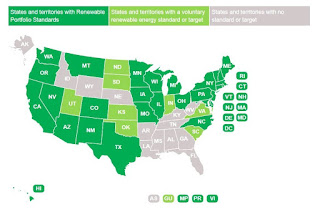A renewable portfolio standard tells utility companies how much of their electricity should come from renewables by certain dates.
Many states in the US have renewable portfolio standards. California, not surprisingly, has the highest goal — 50% renewables by 2030. Some have none at all. See the National Conference of State Legislatures web page for specific information about each state. Naturally, the states that have no RPS are places where Trump supporters live, people who believe deep in the hearts that governments have no business telling industries what they should or should not do, no matter how much harm their activities may cause others.
In Massachusetts, the current RPS is 13% — not the worst in the nation but far behind many other states. The standard goes up by 1% a year, but a new law passed this week by the legislature would increase the standard by 2% a year for 10 years beginning January 1, 2020. On January 1, 2030, the yearly increase would fall back to 1% a year unless the legislature further amends the law in the meantime. That means by 2030, the RPS in Massachusetts will be about 35% — far behind California and several other states that have adopted policies calling for 50% renewables by that date.
Read more at Massachusetts Legislature Approves Higher Renewable Portfolio Standard

No comments:
Post a Comment